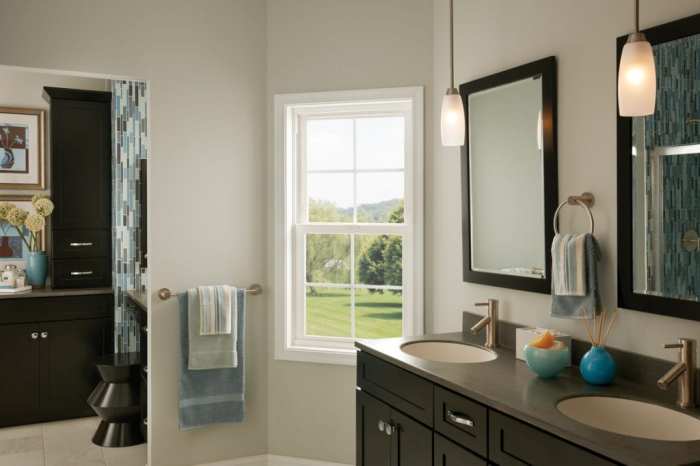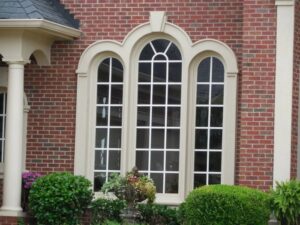
Windows that improve natural lighting are a game changer for any home, transforming dull spaces into vibrant, inviting areas filled with sunshine. The strategic use of windows not only enhances the aesthetic appeal of a room but also significantly boosts the mood and well-being of its inhabitants. By understanding the various types of windows and how they can be optimized for light exposure, homeowners can make informed choices that elevate their living environment.
From the design and placement of different window styles, such as casement and sliding, to the materials used that maximize transparency, there’s so much to consider. Moreover, integrating natural lighting with outdoor features—like landscaping around pools—can further amplify the effect, making every room feel airy and bright.
Importance of Windows in Enhancing Natural Lighting

Windows play a crucial role in enhancing natural lighting within a home. They not only provide a view of the outside world but also allow sunlight to enter, significantly impacting the ambiance and energy efficiency of a space. Properly designed windows can transform a dimly lit room into a vibrant, inviting area, making it essential to understand the various aspects of window design and placement.Different types of windows can significantly improve the influx of natural light.
For instance, larger windows or those with fewer obstructions can maximize sunlight exposure, while strategically placed skylights can channel light into otherwise dark areas. The material and style of the windows, such as casement, sliding, or picture windows, also influence how much light enters a room.
Design Considerations for Maximizing Sunlight
When planning to maximize sunlight through window placement, several design considerations come into play. The orientation of the windows, the presence of overhangs, and the surrounding landscape all affect how light enters a home.
- Orientation: South-facing windows typically receive the most sunlight throughout the day, while north-facing windows offer more consistent, softer light.
- Overhangs: Roof overhangs can be designed to block excessive summer sun while allowing winter sunlight to penetrate deeper into rooms, maintaining comfort and efficiency.
- Landscaping: Trees and shrubs can create shadows that limit sunlight. Thoughtful landscaping can enhance natural lighting by strategically placing greenery away from windows.
Impact of Window Size and Shape on Brightness
The size and shape of windows significantly influence the overall brightness of a room. Larger windows allow more light to flood in, while the shape can create visual interest and affect how light disperses.
For example, floor-to-ceiling windows can create a seamless connection with the outdoors and maximize daylight, while narrow or small windows may restrict light, leading to darker interiors. Additionally, windows with geometric shapes can reflect light in unique ways, enhancing brightness and creating artistic visual effects within the space.
“The right window design not only illuminates a room but also elevates the mood and enhances the overall living experience.”
In practical terms, incorporating large windows in living areas, such as in open floor plans, can transform the ambiance. A spacious living room with ample natural light fosters a welcoming atmosphere, perfect for family gatherings or relaxation. The careful selection of window types and sizes can ultimately shape the character and functionality of a home.
Types of Windows That Maximize Natural Light

Windows serve as the eyes of a home, allowing natural light to flood in while enhancing the overall ambiance. Selecting the right type of window can significantly improve light exposure, which not only brightens spaces but also contributes to energy efficiency. Understanding the various styles and materials available can help in making informed choices that elevate the living experience.
Window Styles That Enhance Light Exposure
Different window styles offer unique benefits when it comes to maximizing natural light. Here are some popular window types that are particularly effective at enhancing light exposure:
- Casement Windows: Hinged at the side, these windows open outward, allowing for maximum ventilation and unobstructed views. Their large glass area helps to let in ample natural light.
- Sliding Windows: Featuring a sleek design, sliding windows operate on a track, making them easy to open. Their expansive glass panels provide excellent light entry and are ideal for modern homes.
- Bay Windows: These protruding windows create a nook inside the room and can include multiple panels. Bay windows not only add to the aesthetic appeal but also capture light from different angles.
- Picture Windows: Fixed windows offering unobstructed views, picture windows are designed solely to let in light and frame scenic outdoor views without the distraction of window frames.
- Skylights: Installed in the roof, skylights facilitate direct sunlight entry from above, significantly brightening darker spaces, such as hallways or bathrooms.
Materials That Promote Transparency and Light Passage
The materials used in window construction play a crucial role in enhancing transparency and facilitating natural light. Here’s a look at some common materials:
- Low-Emissivity (Low-E) Glass: This specialized glass has a thin coating that reflects heat while allowing maximum light transmission, making it a popular choice for energy-efficient windows.
- Tempered Glass: Stronger than regular glass, tempered glass can be used in larger panes without sacrificing safety. It provides a clear view and high light transmittance.
- Fiberglass Frames: These frames are durable and can accommodate larger glass panes, allowing for more light without compromising structural integrity.
- Aluminum Frames: Lightweight and strong, aluminum frames can support expansive glass surfaces, making them ideal for modern aesthetics that prioritize natural light exposure.
Innovative Window Designs Focused on Energy Efficiency and Natural Lighting
Innovations in window design have led to products that not only enhance natural light but also improve energy efficiency. Examples include:
- Smart Windows: These windows can tint or adjust their transparency based on sunlight intensity, helping to regulate indoor temperatures and reduce energy consumption.
- Triple-Pane Windows: Featuring three layers of glass, these windows provide superior insulation while allowing ample light to filter through, making them ideal for energy-conscious homeowners.
- Window Films: Applied to existing windows, these films can reduce glare and UV exposure while maintaining high levels of natural light.
- Photovoltaic (PV) Windows: These innovative windows incorporate solar cells, generating electricity while still functioning as transparent barriers that allow light to enter.
Integration of Natural Lighting with Outdoor Features
Natural lighting can significantly enhance the ambiance of a home, and integrating it with outdoor features can elevate the overall aesthetic appeal. By thoughtfully designing outdoor spaces and utilizing materials like stone and brick, homeowners can create harmonious transitions between indoor and outdoor environments. This not only maximizes natural light but also enriches the visual experience of the living space.Stone brick structures, such as patios, walkways, or retaining walls, can beautifully complement window designs, creating a cohesive look.
The texture and color of stone can reflect natural light, enhancing the brightness of adjacent indoor areas while adding depth to the outdoor landscape. The use of natural materials brings an organic feel to the environment, establishing a connection between the building and its surroundings.
Landscaping Around Swimming Pools and Spas
Strategically landscaping around swimming pools and spas can reflect and enhance light entering through windows. The following techniques can be employed to maximize the effect of natural light in these areas:
Water Features
Incorporating fountains or waterfalls can create shimmering reflections that enhance light diffusion. The movement of water can also create a soothing sound, adding to the overall relaxation experience.
Light-Colored Decking and Surrounds
Using light-colored materials for decking can help reflect sunlight, increasing the brightness of the area around the pool or spa. This not only enhances the aesthetic but also creates a more inviting atmosphere.
Strategic Planting
Planting low shrubs or ornamental grasses around the pool area can enhance visibility and light entry without obstructing views. This allows for beauty and utility, ensuring that the natural light maintains its path into the home.
Mirrored Surfaces
Incorporating mirrored surfaces or reflective tiles near the pool can bounce light back into the surrounding spaces, amplifying the natural lighting effect throughout the home.
Garage Positioning and Natural Light Access
The positioning of a storage garage can significantly influence natural light access to adjacent living spaces. An optimal garage placement enhances the flow of natural light into the home, increasing the overall livability and energy efficiency of the space. Consider the following factors when planning garage positioning:
Orientation
Positioning the garage on the north side of the property allows southern light to filter into the living areas, maximizing sunlight exposure.
Height and Structure
A garage with a lower profile can prevent obstruction of light to windows in nearby rooms. Additionally, a garage that uses design elements like clerestory windows can maintain light access while fulfilling storage needs.
Landscaping
Thoughtful landscaping around the garage can diffuse shadows and enhance light penetration. Maintaining clear sightlines from windows to the outdoors ensures that natural light reaches deeper into the living spaces.
Use of Translucent Materials
Incorporating translucent materials in garage doors can allow light to penetrate while maintaining privacy, thus contributing positively to the indoor lighting environment.By integrating these outdoor features with careful planning and design, homeowners can significantly enhance natural lighting, creating a more enjoyable and aesthetically pleasing living space.
Final Conclusion
In conclusion, investing in windows that improve natural lighting not only enhances the beauty of your home but also contributes to a healthier and more positive living space. By choosing the right window types and thoughtfully considering their placement and integration with your outdoor areas, you can create an environment that truly benefits from the abundance of natural light. Embrace these insights and let the sunshine in!
Key Questions Answered
What types of windows are best for natural lighting?
Windows like bay, casement, and sliding are excellent choices as they offer larger openings for light to enter.
How can window size affect natural light?
Larger windows typically allow more light into a space, while smaller windows may restrict light flow, impacting the room’s brightness.
Can window placement influence light exposure?
Yes, strategically placing windows to face south or west can maximize sunlight exposure throughout the day.
What materials are recommended for windows to enhance light?
Clear glass is ideal, while low-E coatings can help balance light and thermal efficiency without compromising transparency.
How does landscaping affect natural lighting through windows?
Thoughtful landscaping can reflect light into your home, while overgrown trees or shrubs can block sunlight, diminishing natural light.






